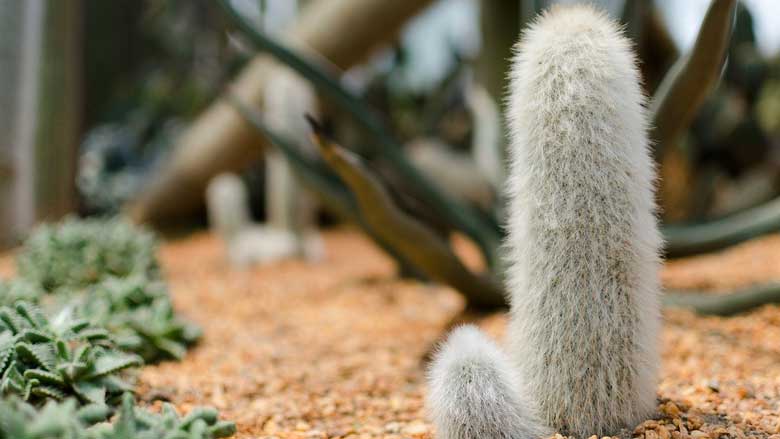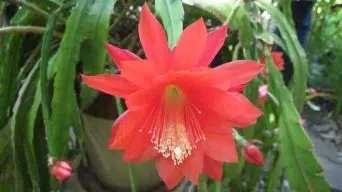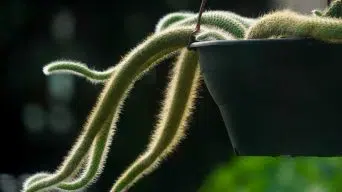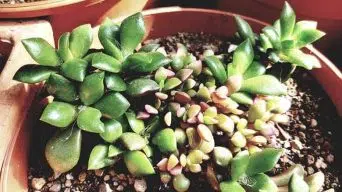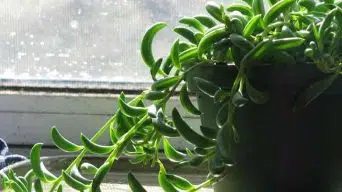Cacti are some of the most beautiful and interesting plants in existence. They are not only aesthetically pleasing but also very easy to care for.
One particular type of cactus that is amazing to look at is called an Old Man Cactus (Cephalocereus senilis).
It is a hardy plant and should stay alive for quite some time with proper care.
This article will teach you all you need to know about these plants and how to take care of them.
Overview
The Old Man Cactus (Cephalocereus senilis) is a succulent plant member of the Cactaceae family native to Guanajuato and Hidalgo, Mexico.
It is a tall, columnar cactus with clusters of unbranched stems that may reach 5-15 m in height.
The Old Man Cactus is completely covered in modified spines that appear as white hair. These spines, which seem like the shaggy hair of an older man, grow long.
The young cactus has a stunning silvery-white coat; the stem loses its covering as the plant matures.
The Old Man Cactus flowers are red, yellow, or white, but the plant may take ten to twenty years to bloom.
Old Man Cactus may live to be 200 years old under the right circumstances.
The Cephalocereus senilis is often known by the following names:
- Old Man Cactus
- Hairy Cactus
- Old Lady Cactus
- Old Man of Mexico
- Bearded Cactus
How To Care for the Old Man Cactus (Cephalocereus Senilis)
Old Man Cactus care is relatively easy if you know a few things about their simple needs.
The essential details about caring for Old Man Cactus are listed below.
Sun Exposure & Light Requirements
The Old Man cactus plant loves to have bright sunlight. It needs at least 6 hours of direct sunlight or at least 8 hours of indirect sunlight.
The Old Man cactus can tolerate full sun because the long white spines provide some protection.
If you live in an area where the sun shines directly on your cactus, I recommend that you rotate it always to have the same orientation.
When indoors, it’s a good idea to locate the Old Man cactus as close as possible to south or west windows, where the light is usually brighter.
The more sunlight your cactus receives, the more flowers it will produce. Sometimes, a large old man cactus can have up to 20 flowers at one time!
Watering Requirements
The Old Man Cactus needs to be watered when the soil is completely dry.
In general, it needs to be watered about once or twice per month, but this will depend on factors like the temperature and sunlight the plant gets.
When you water your cactus, ensure the soil has completely dried before adding more water to it.
It’s a good idea to find a container for your cactus with drainage holes so that excess water can drain out.
As long as you water your cactus when it’s dry and give it enough sunlight, the plant should do quite well for itself.
Soil Requirements
The Old Man Cactus prefers a loose, fast-draining soil. A cactus soil mix is a good option; however, any well-draining soil mix will do.
In nature, old man cactus tends to grow in gravelly or sandy soils, both of which make for an excellent growing medium.
If you want to mix your own soil, a general rule of thumb is that the mix should be one part coarse sand, one part perlite, and 1-2 parts potting soil.
The soil should be well-draining and not hold water, leading to root rot.
If you live in a humid area with high rainfall or humidity, it’s best to take extra precautions, such as placing your cactus pot on top of the soil rather than burying it within it so that excess moisture will drain away from it the roots.
Temperature and Humidity
The Old Man Cactus (Cephalocereus senilis) thrives at a daytime temperature of 22 – 28° C (71 – 82° F) with a slight variation during the night.
During winter, when less light is entering the plant’s environment, it can tolerate cooler conditions as low as 15°C (59°F).
But never allow the temperature to fall below 10°C (50°F).
Regarding the humidity, it grows well in dry regions (less than 50% relative humidity) and indoors.
If grown in a terrarium, make sure to provide excellent ventilation to prevent rot.
Fertilizing
The Old Man Cactus requires very little fertilizer. Use a balanced (20-20-20) water-soluble fertilizer during the growing season for the best results.
Dilute to half recommended strength and apply weekly to two-week intervals as needed.
Be careful not to over-fertilize. Old Man Cactus plants are tough, but fertilizers with too much nitrogen will result in soft, succulent growth that is more susceptible to pests and disease.
It is unnecessary to fertilize during the winter months, as this cactus is mainly a spring/summer grower.
Potting and Repotting
The Old Man Cactus is usually grown in a container, although it can also be grown outdoors if the weather conditions are carefully monitored.
The pot of an Old Man Cactus should be kept in proportion to the size of the plant. The branches of an Old Man Cactus can grow up to several meters long, so for this reason, large pots are required for a healthy plant.
Since the Old Man Cactus requires good drainage, it is important to fill the bottom of the pot with rocks or broken pieces of ceramic before adding soil. Make sure that there is enough room between the ground and the rim of the pot
Cacti are usually potted in porous soil with adequate drainage to avoid root rot, although some gardeners prefer to pot their cacti using only gravel.
The Old Man Cactus is repotted once every three years until the maximum size has been achieved, and then every five to eight years.
Some gardeners will repot the cactus more frequently if the soil seems to lose its ability to hold water.
Pruning
The Old Man Cactus plant doesn’t need to be pruned. It will grow larger, and sometimes the plant becomes too large to carry.
In this case, you will need support or a chain to hold up the branches safely.
If this isn’t an option, cut off the bottom of the main branch using a sharp scissor which becomes heavy for its own strength.
This way, it can stand up by itself.
You can brush the branches using a soft paintbrush to keep them clean. This prevents dust and dirt buildup that could block out light or water.
Pests and Diseases
The Old Man Cactus is often the victim of bugs like aphids, mealybugs, and red spider mites.
Usually, they are quickly taken care of by using a cotton swab dipped in alcohol to remove them.
Also, pests can be removed using insecticidal soap, which can be found at any garden center.
This process must be done consistently to get rid of the bugs for good.
The Old Man Cactus is also susceptible to stem rot, root rot, and Trichocereus fungal disease.
The best way to prevent these diseases is to water the plant at its outer edges rather than pour water on top.
Also, make sure that the soil is dry before adding more water.
If these diseases do occur, the only option is to remove as much as possible of the infected material and then replant.
This will remove the disease from the plant.
How to Care for the Old Man Cactus in Winter
Old Man Cactus winter care consists of keeping the plant warm and dry during the cold months.
The Old Man Cactus should be kept indoors during the cold months in cold regions. A heated home is usually ideal for these plants.
If you are growing the cactus indoors, place it near a sunny window where it will receive direct sunlight throughout the day and avoid cold drafts.
As with any plant, the soil should be kept as dry as possible during winter. If you are growing your Old Man Cactus indoors, water only when the soil’s surface is completely dry – usually once or twice a month.
If you keep your cactus outdoors and it snows, remove all snow from its surface to avoid rotting the plant’s roots.
When growing your cactus outdoors, stop watering it during the cold months and allow the soil’s surface to dry up completely.
The cactus will be dormant during winter – its growth cycle slows down considerably or even stops altogether, depending on climate conditions.
How To Propagate the Old Man Cactus (Cephalocereus Senilis)
The Cephalocereus senilis, the Old Man Cactus, can be easily propagated from seeds. Seed propagation is regarded as the only technique by some people.
To properly germinate the seeds of the Old Man Cactus:
- Put some sand or potting mix into a small container and moisten it.
- Press your Cephalocereus senilis seeds (1-2 mm in diameter) halfway into the moistened cactus soil mix.
- Cover the seeds with a thin sand or potting mix layer and moisten them again.
- Keep your seeds at 20°C to 25°C (68°F to 77°F) and put them in bright light or direct sunlight.
- Keep the soil moist and spray it once daily, but ensure it doesn’t get wet and soggy.
The seeds will germinate within 14 days to 3 months, depending on their maturity at the time of sowing.
After the seeds germinate, keep the soil mix moist.
Cut back on watering once the seedlings have developed strong root systems but still water them from time to time. Make sure that they get enough light.
They will be ready to transplant when they are 10 cm to 15 cm (4 into 6 in) tall, with three or more branches.
Final Thoughts
The Old Man Cactus plant is a beautiful and odd addition to any home.
Old Man Cactus care and propagation are easy as long as you follow all the steps outlined here.
Additionally, do not forget that this plant likes to be dry more than wet.
The Old Man Cactus is a unique cactus that can bring great joy with its beautiful flowers, and it does not hurt that it has an interesting name.

